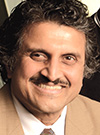Pitt Researchers Are Working to Mass-Produce Stem Cells
Human stem cells hold great promise for medicine: They can be used therapeutically, they can help model disease, and they can be used to help discover new drugs. But it is very difficult to culture enough cells to meet the demand.
 Pitt’s Ipsita Banerjee recently received a $300,000 grant from the National Science Foundation to explore her idea about how to manufacture human pluripotent stem cells—ones that can become virtually any tissue—on an industrial scale. Banerjee is an associate professor of chemical and petroleum engineering and of bioengineering in Pitt’s Swanson School of Engineering.
Pitt’s Ipsita Banerjee recently received a $300,000 grant from the National Science Foundation to explore her idea about how to manufacture human pluripotent stem cells—ones that can become virtually any tissue—on an industrial scale. Banerjee is an associate professor of chemical and petroleum engineering and of bioengineering in Pitt’s Swanson School of Engineering.
At present, Banerjee says, culturing stem cells is a delicate proposition, because the initial cell-seeding population survives only 30 percent of the time. Current methods are limited by this low viability and by the tendency for the cells to be heterogeneous, a problem when uniformity is required.
Banerjee and co-investigator Prashant Kumta, professor of bioengineering, think that they will be able to overcome those obstacles by creating a biomimetic hydrogel encapsulation system that mimics the cell-to-cell interaction that stem cells require to survive.
 “It’s kind of a simple idea, but it hasn’t been done,” Banerjee says. “I thought someone must have done it, at least with other kinds of cells, but no one has.”
“It’s kind of a simple idea, but it hasn’t been done,” Banerjee says. “I thought someone must have done it, at least with other kinds of cells, but no one has.”
The capsules she and Kumta plan to create will use an as-yet-unidentified peptide to convince individual cells they’re in the company of others, enhancing survival. “[A cell] will think that it is in contact with another cell and will not activate the cell-death pathway,” Banerjee says.
If they find the right peptide and their theories about stem cell behavior and viability are confirmed, Banerjee and Kumta are hopeful that their method of stem-cell cultivation will allow labs around the world to generate enough stem cells to meet demand.
“Our method is cheap and simple,” Banerjee concludes. “If we’re right, just about anyone in any lab will be able to reproduce it.”
Other Stories From This Issue
On the Freedom Road

Follow a group of Pitt students on the Returning to the Roots of Civil Rights bus tour, a nine-day, 2,300-mile journey crisscrossing five states.
Day 1: The Awakening
Day 2: Deep Impressions
Day 3: Music, Montgomery, and More
Day 4: Looking Back, Looking Forward
Day 5: Learning to Remember
Day 6: The Mountaintop
Day 7: Slavery and Beyond
Day 8: Lessons to Bring Home
Day 9: Final Lessons

